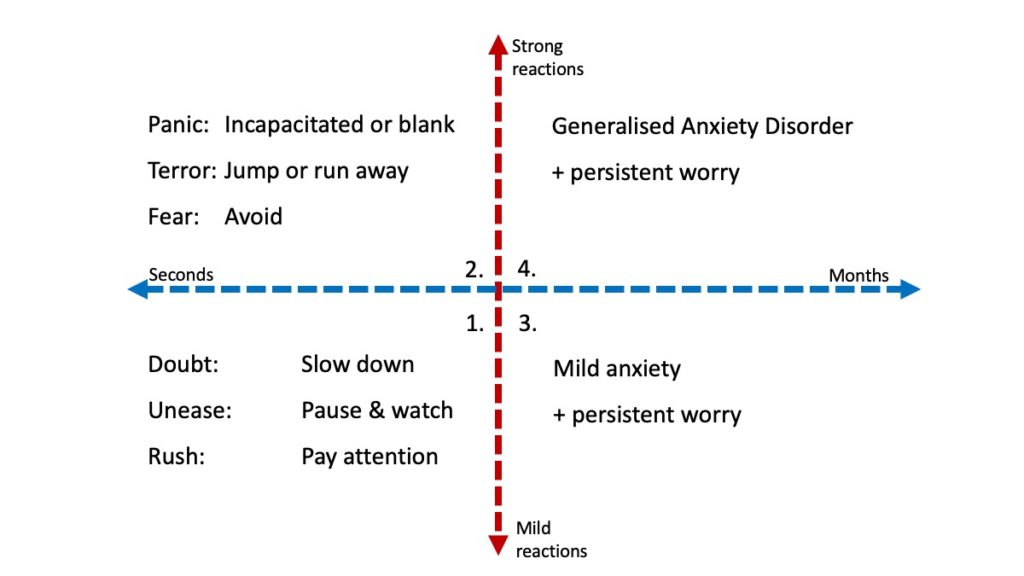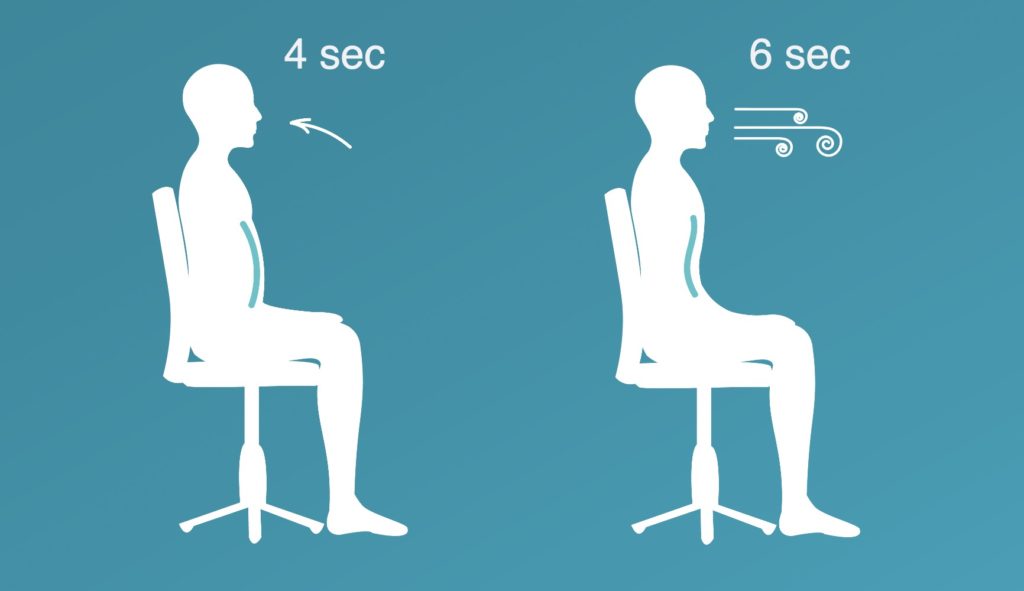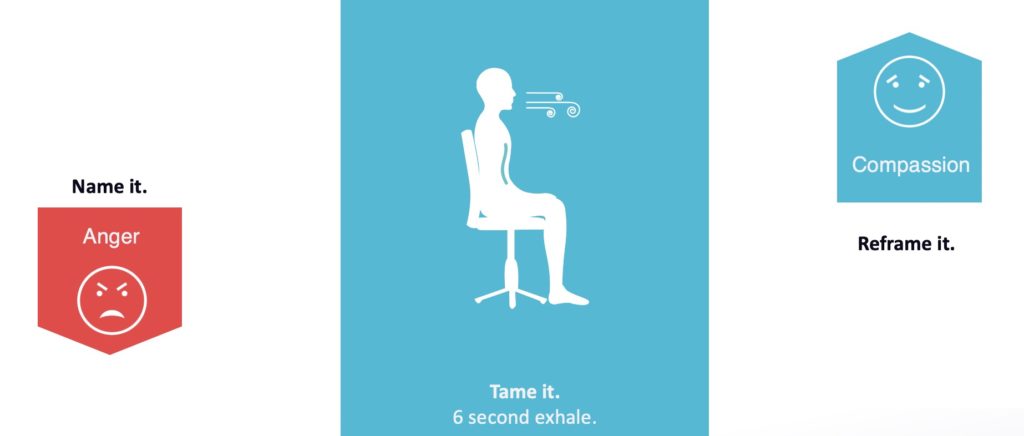
How to Overcome Anxiety
He dare not come into company for fear he should be misused, disgraced, overshoot himself in gestures or speeches, or be sick; he thinks every man observeth him. – Robert Burton, 1621, quotes Hippocrates describing a patient.
If you are feeling a little uncertain, uneasy, anxious or worried, you are in good company. We will remember 2020 for fires, Covid-19, floods, hurricanes, moral outrage, and massive job losses. There is little to indicate that we are ‘going back to normal.’
We hear from our clients, colleagues and reputable media that anxiety is the most troubling concern right now. Anxiety is both unpleasant and debilitating. It can range from a very appropriate and necessary recognition of risk to being immobilised in a state of panic.
Depending upon the situation, anxiety can be a life-saving super-power or alternatively, a psychiatric diagnosis of mental illness.
A clear understanding of how anxiety works and practical steps to counter it will guide you back to calm and curious playfulness.
The five steps are:
- Name it
- Tame it
- Breath control
- Reframe it
- Press PLAY
Understanding Anxiety
A Psychiatric Perspective
Large population surveys show that up to 33.7% of people are affected by an anxiety disorder. The Anxiety and Depression Association of America (ADAA) claims that 18.1% of adults are affected and 25.1% of young people (13 – 18).
An “anxiety disorder” in the DSM-5 is diagnosed by excessive anxiety and worry (difficult to control) occurring most days for six months about a number of events or activities. Symptoms include restlessness (on edge), fatigue, difficulty concentrating, irritability, muscle tension, and sleep disturbance.
Psychiatrists apply a wide range of descriptions including anxiety disorder, panic disorder, agoraphobia, generalized anxiety disorder, social anxiety disorder, specific phobia, and separation anxiety disorder.
Treatment is counselling, CBT or anxiety medications. The pharmaceutical market is worth about $7 billion (excluding antidepressants ($18 billion) often prescribed for anxiety).
You cannot die from an anxiety disorder or even a panic attack. However, prolonged anxiety has been shown into increase risk of cardiovascular disease and can make inflammatory disorders such as asthma and rashes worse.
A Biological Perspective
Anxiety is linked to the primary emotion of fear. Fear exists from reptiles through to humans. Fear has been retained in evolution because it increases the chance of living long enough to reproduce. In a dangerous world of predators and deprivation, fear saves lives. It is so important, that the flight reaction is a powerful, automatic reaction to threat.
The flight reaction activates before you can think about it. When the senses detect a threat, the amygdala and hypothalamus fire up the sympathetic nervous system. You are flooded with adrenaline. Blood leaves your brain, skin and gut to power up the leg and butt muscles so that you can run.
Just as an impala might dash off with a whiff of a lion, so you might jump away at the sight of a coiled object in your path. Thinking in humans only happens after the event. Your body, gripped by a surge of fear, may just have saved your life.
At the milder end of the anxiety range, is a sense of doubt or unease. A very mild activation of the fear response leaves you feeling uncomfortable (butterflies), tense (neck and back) and wide-eyed. The experience could be triggered by a creak of a door or even an imagined threat. Either way, it wakes you up, you pay attention and prepare for a threat.
There are two dimensions of anxiety: severity and duration as shown here. A quick surge of fear can alert you to threat and help you focus on mastering the situation (1). But we have to tame the fear in order to be calm, focused and connected to the situation. Too much fear will make us rigid and unable to respond with skill (2).

When fear persists and is experienced as chronic anxiety and persistent worry, it is of no adaptive use (3). Chronic anxiety will undermine your life and health (4). It feels awful, thinking is compromised, and you may find yourself avoiding and procrastinating in the face of challenges you need to address.D
Anxiety can be understood from physical, emotional and mental perspectives.
The body is activated by adrenaline, blood flow changes, muscle tension, breathing, and heart rate. We can experience this as a physical experience. The bodily state is felt as a feeling, or emotion, of fear. This fear can express as unease, wariness, terror or even panic. These are emotions we can learn to label accurately. They can be captured on camera and in voice.

Fear focuses our attention on future threats. You may notice yourself thinking: ‘this could be scary’. That is a useful thought that helps you plan and prepare. However, you may find your mind looping around the same thoughts: ‘this is terrible, what if, this is going to hurt, they will hate me.’ This is worry. It is not helpful. Your mental resources are distracted from the present moment.
The five steps from anxiety to playfulness
Name it
When you experience anxiety in the body, feel it as emotion, or notice it as worry, name the experience immediately. For example: ‘I feel my heart thumping’, ‘I feel fear’, or ‘I am worrying about x. The goal is to make an object of the experience.
If we don’t name it, we become the subject. We feel lost in a whirl of heart thumping, dread, and swirling worries. You feel like you are the flight reaction. Your reptilian brain is in control.
This step puts you in control as the observer. My body is tense. This is a feeling of fear. My mind is caught in a worry loop. You have just put your pre-frontal cortex in control. The reptilian systems immediately deactivate when you name it. Now you have access to conscious perception, judgement, creativity and can choose the best response.
Tame it
Once you name the state, feeling or thought, the experience of anxiety and fear is already reducing. There are many tactics to achieve this. Relax your face, breathe out and pause, massage your neck and shoulders, have a cold shower, sing, gargle or reach out for a hug.
Learn how to focus attention on your body or the flow of your breath. Each time the mind charges off to worry, gently bring it back to the rise and fall of your belly.
There is tremendous power in learning to do this well. I believe every student should be taught these skills early in education. It will be life changing. If you know you can reduce your anxiety with practical steps.
Breath Control
Our most popular blog is “Take a Deep Breath is Bad Advice.” Taking a deep breath, especially if it is through the mouth makes anxiety worse. Rapid, shallow and chesty breathing can combine with breath holding and sighing. These are signs of hyperventilation. You may be breathing 18 times per minute. If you hyperventilate deliberately, you will feel anxiety rise.
To start, lie flat, close your eyes, relax face, body and limbs, and exhale fully. Pause a moment and then inhale through your nose. Aim for ten second breath cycles. My preference is 4 seconds in (1, 2, 3, 4) and 6 seconds out (5, 6, 7, 8, 9, 10). Keep your chest and belly relaxed. Allow your lower ribs and belly to rise and fall as you breathe.
Two or three minutes of this slow, diaphragmatic breathing through the nose has a huge impact. If you can accumulate this sort of breathing for about 8 minutes a day your vagal tone becomes stronger and your brain becomes more focused and agile.
The next step might be to learn and practice a meditation. Try to do this every day even if for just five minutes.

Reframe it
A reframe is consciously and deliberately choosing a different state. You take your body from tense to relaxed. You nudge your feelings from fear to calm. You test the worry with thoughts of hope and opportunity. The concept comes from CBT (cognitive behaviour therapy). You can reframe body, emotion or thought.
The All Blacks use the term ‘comfortable with the uncomfortable’. Ceri Evans (see below) uses the aphorism: ‘Red or blue? Decide! Do!’ Approaching a difficult play, notice the fear (red), step back, step up to focus on the goal (blue) and step into deliberate action.
By practicing these disciplines repeatedly, you can learn to reframe in a split second.
Notice that we are not advocating that you deny feeling. The information is an important message. Use it to quickly reframe your body, emotion and mind into a state that can solve the challenge.

Press PLAY
When you look at memorable learning moments in your life, they are often found where you confronted big and scary challenges. There is nothing more rewarding than finding a way to engage adversity with curiosity and a sense of play. This is what young animals do in play. In play we engage voluntarily with adversity. We chase, we run, we wrestle, and develop the skills to be able to do it under pressure.
- Develop a habit of playful engagement. When adversity presents:
- Feel the fear and name it
- Breath out and relax your body
- Step back and up to look around
- Say to yourself: ‘this is interesting, there must be 7 ways to play.’
- Make a decision
- Execute
As you keep practicing this your attitudes to adversity will change from threat to playful opportunity. As your skills improve, you vagus nerve will myelinate and get stronger. Calm, focused connection becomes easier. You will learn to trust yourself.
Life and its challenges become a playground for adventure.
References:
- Joseph LeDoux, Anxious, 2015 (a sound neurobiologist)
- Jean Twenge, i-Gen, 2017 (researcher on young people)
- Ceri Evans, Perform under Pressure, 2019 (how All Blacks do it)
- Deb Dana, Polyvagal Exercises for Calm and Connection, 2020 (get it)
